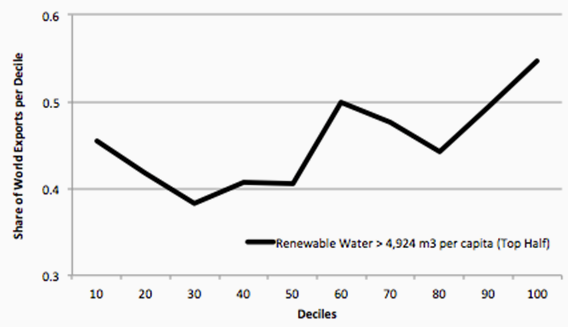As the severe drought in key US farming states continues, worries mount over rising food prices. This recent drought is but one of many events that underscore how freshwater scarcity will be a major challenge of the 21st century. Almost one fifth of the world’s population currently suffers the consequences of water scarcity, and this number is expected to increase (UNESCO 2009). Moreover, population growth, pollution, rising standards of living, and the diet and lifestyle changes they imply will continue to increase the demand for water and strain available water resources.
In spite of reports about an impending water crisis, the world is not running out of water. For one, fresh water is a finite but renewable global resource. In addition, there is more than enough fresh water on earth to satisfy the growing demand.
The major concerns about water availability stem especially from the very uneven global distribution of water. While many countries clearly have more than enough water to satisfy their populations' increasing needs, some countries do not. Because water scarcity is tied to particular regions, it is easy to understand why analyses of and policy solutions for water scarcity have traditionally had a local focus. Only recently have scientist realised that a global framework is needed (Hoekstra et al 2008 and Vörösmarty et al 2000).
A global perspective
Most of the things we produce require water, and often much more water than people are aware of. One single apple, for example, has a water footprint of 700 litres, and it takes 24,000 litres before you can buy one kilogram of chocolate in the store. My study (Debaere 2012) explicitly studies water as a source of comparative advantage and investigates whether countries use water efficiently on a global scale. In other words, I investigate whether countries with relatively scarce water resources shift their production and exports away from more water-intensive goods (i.e. goods whose production requires, compared to other factors, more water) to less water-intensive goods. In a world in which international trade is possible, those water-scarce countries can then buy water-intensive goods from countries that do not face any significant water resource constraints.
Figure 1 below shows that such an international specialisation of production and trade is, at least to some extent, taking place. It shows the share of world exports for the 65 most water-abundant countries of the world in ten groups of goods that are classified by increasing water intensity. As one can see, the export share of the water-abundant countries tends to increase with the water intensity of the export goods.
Figure 1. World export share by decile of water intensity for the most water-abundant countries
Source: Blackhurst et al. (2010)
Notes: Products are split into deciles of green and blue water intensity. The share of world exports is calculated by dividing the exports of the most water-abundant countries (half the countries in the sample have more than 4,924m3 per capita renewable water resources) by total world exports in each decile. Source: Using BHV (2010) data.
Econometric evidence confirms that water is a significant factor in determining the international pattern of exports, while controlling for other production factors such as capital, skilled labour and land. At the same time, my estimates indicate that the traditional production factors, i.e. capital and skilled labour, play a much more important role in determining the pattern of international trade (and production) than does water. From a global perspective and in light of the current debate about climate change, this evidence suggests that changes in the pattern of trade due to changing precipitation and water availability should be contained. Needless to say, this finding comes with two important caveats. Individual countries that are heavy exporters of agricultural products which tend to be very water intensive may experience non-negligible disruptions. Countries such as Australia could see their exports decrease by almost 5% in light of a 10% decrease in water resources. A second important caveat is that my estimates take the current policy environment of often distorted water prices as given.
Beginning of the road
Global economic analyses of water scarcity are few, in spite of the imminent water crises, the extensive international trade literature, and the wealth of data from water studies outside economics. While more research is needed, especially on the specific impact of trade policy on water use, my study suggests that open markets that make the international specialisation of production possible may offer a way to fight water scarcity.
References
Blackhurst, B.M., Hendrickson, C., and J.S. Vidal (2010), “Direct and Indirect Water Withdrawals for U.S. Industrial Sectors,” Environmental Science Technology, 44: 2126–30.
Debaere, P. (2012),”The Global Economics of Water: Is Water a Source of Comparative Advantage?”, CEPR Working Paper, No. 9030.
Hoekstra, A. Y. and A.K. Chapagain ( 2008), Globalization of Water: Sharing the planet’s freshwater resources, Blackwell Publishing.
Vörösmarty, C.J., Green, P., Salisbury, J. and R.B. Lammers, (2000), “Global Water Resources; Vulnerability from Climate Change and Population Growth”, Science 289: 284–288.


